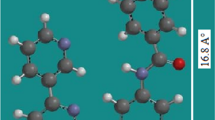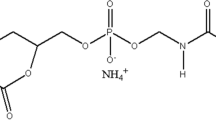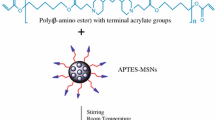Abstract
Mesostructured SBA-15 silica materials have been successfully dual functionalized with polyethyleneimine (PEI) groups and C60 fullerene moieties to allow an evaluation of their properties as nanovehicles for controlled drug delivery. Methylprednisolone sodium succinate was selected as a model drug for adsorption on the surface of functionalized SBA-15 silica materials. The resulting dual-functionalized SBA-15 silica materials exhibit mesoscopic arrangements, although with a remarkable reduction in their textural properties as compared to pure silica SBA-15. The adsorption capacity of methylprednisolone on functionalized SBA-15-PEI improved remarkably compared with that of raw SBA-15, while the drug release rate slowed, as the amount of PEI anchored in the SBA-15 increased. The strong attractive electrostatic interactions between methylprednisolone and the silica surfaces of SBA-15-PEI materials, measured by zeta potential, account for these results. In a second step, wherein C60 fullerene species in combination with PEI were grafted to the silica, the results establish that the steric effects and hydrophobicity of the C60 moieties hinder methylprednisolone transport within the silica pores. The kinetic parameters obtained from the drug release profiles, fitted to four kinetic models, show that the incorporation of C60 species yields lower methylprednisolone release rates from SBA-15-PEI-C60 materials than from SBA-15-PEI materials. Additionally, the incorporation of fullerene groups into PEI-modified materials provides an increment in cell viability. Confocal microscopy evidences the cellular internalization of the dual-functionalized mesoporous SBA-15 materials inside the plasmatic membrane.










Similar content being viewed by others
References
Vallet-Regí M, Colilla M, Izquierdo-Barba I, Manzano M (2018) Mesoporous silica nanoparticles for drug delivery: current insights. Molecules 23:1–19
Diab R, Canilho N, Pavel IA, Haffner FB, Girardon M, Pasc A (2017) Silica-based systems for oral delivery of drugs, macromolecules and cells. Adv Colloid Interface Sci 249:346–362
Cicuéndez M, Izquierdo-Barba I, Portolés MT, Vallet-Regí M (2013) Biocompatibility and levofloxacin delivery of mesoporous materials. Eur J Pharm Biopharm 84:115–124
Morales V, Gutiérrez-Salmerón M, Balabasquer M, Ortiz-Bustos J, Chocarro-Calvo A, García-Jiménez C, García-Muñoz RA (2016) New drug-structure-directing agent concept: inherent pharmacological activity combined with templating solid and hollow-shell mesostructured silica nanoparticles. Adv Funct Mater 26(40):7291–7303
Karesoja M, McKee J, Karjalainen E, Hietala S, Bergman L, Linden M, Tenhu H (2013) Mesoporous silica particles grafted with poly (ethyleneoxide-block-N vinylcaprolactam). J Polym Sci Part A Polym Chem 51:5012–5020
García RA, van Grieken R, Iglesias J, Morales V, Gordillo D (2008) Synthesis of chiral periodic mesoporous silicas incorporating tartrate derivatives in the framework and their use in asymmetric sulfoxidation. Chem Mater 20:2964–2971
Morales V, Villajos JA, García RA (2013) Simultaneous synthesis of modified Binol-periodic mesoporous organosilica SBA-15 type material. Application as catalysts in asymmetric sulfoxidation reactions. J Mater Sci 48:5990–6000. https://doi.org/10.1007/s10853-013-7395-5
García-Muñoz RA, Morales V, Linares M, González PE, Sanz R, Serrano DP (2014) Influence of the structural and textural properties of ordered mesoporous materials and hierarchical zeolitic supports on the controlled release of methylprednisolone hemisuccinate. J Mater Chem B 45:7996–8004
García-Muñoz RA, Morales V, Linares M, Rico-Oller B (2014) Synthesis of helical and supplementary chirally doped PMO materials. Suitable catalysts for asymmetric synthesis. Langmuir 30:881–890
Morales V, Idso MN, Balabasquer M, Chmelka B, García-Muñoz RA (2016) Correlating surface-functionalization of mesoporous silica with adsorption and release of pharmaceutical guest species. J Phys Chem C 120:16887–16898
Maria Chong AS, Zhao XS (2003) Functionalization of SBA-15 with APTES and characterization of functionalized materials. J Phys Chem B 107:2650–12657
Rosenholm JM, Penninkangas A, Linden M (2006) Amino-functionalization of large-pore mesoscopically ordered silica by a one-step hyperbranching polymerization of a surface-grown polyethyleneimine. Chem Commun 37:3909–3911
Martín A, Morales V, Ortiz-Bustos J, Pérez-Garnes M, Bautista LF, García-Muñoz RA, Sanz R (2018) Modelling the adsorption and controlled release of drugs from the pure and amino surface-functionalized mesoporous silica hosts. Micropor Mesopor Mat 262:23–34
Ortiz-Bustos J, Martín A, Morales V, Sanz R, García-Muñoz RA (2017) Surface-functionalization of mesoporous SBA-15 silica materials for controlled release of methylprednisolone sodium hemisuccinate: influence of functionality type and strategies of incorporation. Micropor Mesopor Mat 240:236–245
Wang S (2009) Ordered mesoporous materials for drug delivery. Micropor Mesopor Mat 117:1–9
Muñoz B, Rámila A, Pérez-Pariente J, Díaz I, Vallet-Regí M (2003) MCM-41 organic modification as drug delivery rate regulator. Chem Mater 15:500–503
Song SW, Hidajat K, Kawi S (2005) Functionalized SBA-15 materials as carriers for controlled drug delivery: influence of surface properties on matrix–drug interactions. Langmuir 21:9568–9575
Cuoq F, Masion A, Labille J, Rose J, Ziarelli F, Prelot B, Bottero JY (2003) Preparation of amino-functionalized silica in aqueous conditions. Appl Surf Sci 266:155–160
Castruita de León G, Perera-Mercado YA, García-Cerda LA, Mercado-Silva JA, Meléndez-Ortiz HI, Olivares-Maldonado Y, Álvarez-Contreras L (2015) Synthesis of amino-functionalized MCM-48 silica via direct co-condensation at room temperature. Micropor Mesopor Mat 204:156–162
Ojeda M, Mazaj M, Garcia S, Xuan J, Maroto-Valer M, Logar NZ (2017) Novel amine-impregnated mesostructured silica materials for CO2 capture. Energy Procedia 114:2252–2258
Kim CO, Cho SJ, Park JW (2003) Hyperbranching polymerization of aziridine on silica solid substrates leading to a surface of highly dense reactive amine groups. J Colloid Interface Sci 260:374–380
Rosenholm JM, Linden M (2007) Wet-chemical analysis of surface concentration of accessible groups on different amino-functionalized mesoporous SBA-15 silicas. Chem Mater 19:5023–5034
Martín A, García RA, Sen Karaman D, Rosenholm JM (2014) Polyethyleneimine-functionalized large pore ordered silica materials for poorly water-soluble drug delivery. J Mater Sci 49:1437–1447. https://doi.org/10.1007/s10853-013-7828-1
Guo A, Wang Y, Xu S, Zhang X, Li M, Liu Q, Shen Y, Cui D, Guo S (2017) Preparation and evaluation of pH-responsive charge-convertible ternary complex FA-PEI-CCA/PEI/DNA with low cytotoxicity and efficient gene delivery. Colloids Surf B 152:58–67
Khansarizadeh M, Mokhtarzadeh A, Rashedinia M, Taghdisi SM, Lari P, Abnous KH, Ramezani M (2016) Biodegradable nano-polymers as delivery vehicles for therapeutic small non-coding ribonucleic acids. Hum Exp Toxicol 34:377–387
Oskuee RK, Dabbaghi M, Gholamic L, Taheri-Bojd S, Balali-Mood M, Mousavi SH, Malaekeh-Nikouei B (2018) Investigating the influence of polyplex size on toxicity properties of polyethylenimine mediated gene delivery. Life Sci 197:101–108
Remant Bahadur KC, Uludağ H (2016) PEI and its derivatives for gene therapy. In: Narain R (ed) Polymers and nanomaterials for gene therapy. Woodhead Publishing, Cambridge, pp 29–54
Taranejoo S, Liu J, Verma P, Hourigan K (2015) A review of the developments of characteristics of PEI derivatives for gene delivery applications. J Appl Polym Sci 42096:1–8
Zhang X, Duan Y, Wang D, Bian F (2015) Preparation of arginine modified PEI-conjugated chitosan copolymer for DNA delivery. Carbohydr Polym 122:53–59
Wong K, Sun GB, Zhang XQ, Dai H, Liu Y, He CB (2006) PEI-g-chitosan, a novel gene delivery system with transfection efficiency comparable to polyethylenimine in vitro and after liver administration in vivo. Bioconjugate Chem 17:152–158
Uritu CM, Varganici CD, Ursu L, Coroaba A, Nicolescu A, Dascalu AI, Peptanariu D, Stan D, Constantinescu CA, Simion V, Calin M, Maier SS, Pinteala M, Barboiu M (2015) Hybrid fullerene conjugates as vectors for DNA cell-delivery. J Mater Chem B 3:2433–2446
Nielsen GD, Roursgaard M, Jensen KA, Poulsen SS, Thor Larsen S (2008) In vivo biology and toxicology of fullerenes and their derivatives. Basic Clin Pharmacol Toxicol 103:197–208
Moussa F (2018) [60] Fullerene and derivatives for biomedical applications. In: Nayaran R (ed) Nanobiomaterials. Elsevier, pp 113–136
Shi J, Zhang H, Wang L, Li L, Wang H, Wang Z, Li Z, Chen C, Hou L, Zhang C, Zhang Z (2013) PEI-derivatized fullerene drug delivery using folate as a homing device targeting to tumor. Biomaterials 34:251–261
Goodarzi S, Da Ros T, Conde J, Sefat F, Mozafari M (2017) Fullerene: biomedical engineers get to revisit an old friend. Mater Today 20:460–480
Kroto HW, Heath JR, O’Brien SC, Curl RF, Smalley RE (1985) C60: buckminsterfullerene. Nature 318(6042):162–163
Lee CH, Lin TS, Lin HP, Zhao Q, Liu SB, Mou CY (2003) High loading of C60 in nanochannels of mesoporous MCM-41 materials. Micropor Mesopor Mat 57:199–209
Zhao D, Feng J, Huo Q, Melosh N, Fredrickson GH, Chmelka BF, Stucky GD (1998) Triblock copolymer syntheses of mesoporous silica with periodic 50 to 300 angstrom pores. Science 279:548–552
Zhao F, Repo E, Song Y, Yin D, Hammouda SB, Chen L, Kalliola S, Tang J, Tam KC, Sillanpä M (2018) Polyethylenimine-cross-linked cellulose nanocrystals for highly efficient recovery of rare earth elements from water and mechanism study. Green Chem 19:4816–4828
Min M, Shen L, Hong G, Zhu M, Zhang Y, Wang X, Chen Y, Hsiao BS (2012) Micro-nano structure poly(ether sulfones)/poly(ethyleneimine) nanofibrous affinity membranes for adsorption of anionic dyes and heavy metal ions in aqueous solution. Chem Eng J 197:88–100
Korsmeyer RW, Gurny R, Doelker E, Buri P, Peppas NA (1983) Mechanisms of solute release from porous hydrophilic polymers. Int J Pharm 15:25–35
Bruschi ML (2015) Strategies to modify the drug release from pharmaceutical systems. Woodhead Publishing, Cambridge, pp 63–86
Higuchi T (1963) Mechanism of sustained-action medication. Theoretical analysis of rate of release of solid drugs dispersed in solid matrices. J Pharm Sci 52:1145–1149
Gallagher KM, Corrigan OI (2000) Mechanistic aspects of the release of levamisole hydrochloride from biodegradable polymers. J Control Release 69(2000):261–272
Ishiyama M, Tominaga H, Shiga M, Sasamoto K, Ohkura Y, Ueno KA (1996) Combined assay of cell viability and in vitro cytotoxicity with a highly water-soluble tetrazolium salt, neutral red and crystal violet. Biol Pharm Bull 19:1518–1520
Zhang J, Desai D, Rosenholm JM (2013) Tethered lipid bilayer gates: toward extended retention of hydrophilic cargo in porous nanocarriers. Adv Funct Mater 24:2352–2360
Desai D, Sen Karaman D, Prabhakar N, Tadayon S, Duchanoy A, Toivola DM, Rajput S, Näreoja T, Rosenholm JM (2014) Design considerations for mesoporous silica nanoparticulate systems in facilitating biomedical applications. Mesoporous Biomater 1:16–43
Bartelmess J, Quinn SJ, Giordani S (2015) Carbon nanomaterials: multi-functional agents for biomedical fluorescence and Raman imaging. Chem Soc Rev 44:4672–4698
Grebowski J, Krokosz A, Konarska A, Wolszczak M, Puchala M (2014) Rate constants of highly hydroxylated fullerene C60 interacting with hydroxyl radicals and hydrated electrons. Pulse radiolysis study. Radiat Phys Chem 103:146–152
Sitharaman B, Tran LA, Pham QP, Bolskar RD, Muthupillai R, Flamm SD, Mikos AG, Wilson LJ (2007) Gadofullerenes as nanoscale magnetic labels for cellular MRI. Contrast Media Mol Imaging 2:139–146
Zhang H, Hou L, Jiao X, Ji Y, Zhu X, Zhang Z (2015) Transferrin-mediated fullerenes nanoparticles as Fe2+ dependent drug vehicles for synergistic anti-tumor efficacy. Biomaterials 37:353–366
Nastase S, Bajenaru L, Matei C, Mitran RA, Berger D (2013) Ordered mesoporous silica and aluminosilicate-type matrix for amikacin delivery systems. Micropor Mesopor Mat 182:32–39
Moritz M (2013) Solvent optimization for niacinamide adsorption on organo-functionalized SBA-15 mesoporous silica. Appl Surf Sci 283:537–545
Sun JT, Piao JG, Wang LH, Javed M, Hong CY, Pan CY (2013) One-pot synthesis of redox-responsive polymers-coated mesoporous silica nanoparticles and their controlled drug release macromol. Rapid Commun 34:1387–1394
Datt A, El-Maazawi I, Larsen SC (2012) Aspirin loading and release from MCM-41 functionalized with aminopropyl groups via co-condensation or postsynthesis modification methods. J Phys Chem C 116:18358–18366
Szegedi A, Popova M, Goshev I, Mihaly J (2011) Effect of amine functionalization of spherical MCM-41 and SBA-15 on controlled drug release. J Solid State Chem 184:1201–1207
Brezoiu AM, Deaconu M, Nicu I, Vasile E, Mitran RA, Matei C, Berger D (2019) Heteroatom modified MCM-41-silica carriers for Lomefloxacin delivery systems. Micropor Mesopor Mat 275:214–222
Zelenák V, Halamová D, Almáši M, Zid L, Zelenáková A, Kapusta O (2018) Ordered cubic nanoporous silica support MCM-48 for delivery of poorly soluble drug indomethacin. Appl Surf Sci 443:525–534
Hoffman R, Benz EJ, Silberstein LE, Heslop H, Weitz J, Anastasi J (2018) Aplastic anemia. In: Hoffman R, Benz E, Heslop H, Weitz J (eds) Hematology: basic principles and practice. Elsevier, Amsterdam. ISBN 978-0-323-35762-3
Acknowledgements
The financial support of the Spanish government (CTQ2014-57858-R and CTQ2017-88642-R) is gratefully acknowledged. J. Ortiz-Bustos thanks the “Ministerio de Economía y Competitividad” of Spain (BES-2012-056525) for the research internship at the Pharmaceutical Sciences Laboratory, Faculty of Science and Engineering, Åbo Akademi University, Finland. The authors thank Dr. Victor de la Peña from the IMDEA Energy Institute, Photoactivated processes Unit, for helping in XPS discussion.
Author information
Authors and Affiliations
Corresponding authors
Additional information
Publisher's Note
Springer Nature remains neutral with regard to jurisdictional claims in published maps and institutional affiliations.
Electronic supplementary material
Below is the link to the electronic supplementary material.
Rights and permissions
About this article
Cite this article
Morales, V., Martín, A., Ortiz-Bustos, J. et al. Effect of the dual incorporation of fullerene and polyethyleneimine moieties into SBA-15 materials as platforms for drug delivery. J Mater Sci 54, 11635–11653 (2019). https://doi.org/10.1007/s10853-019-03708-0
Received:
Accepted:
Published:
Issue Date:
DOI: https://doi.org/10.1007/s10853-019-03708-0




